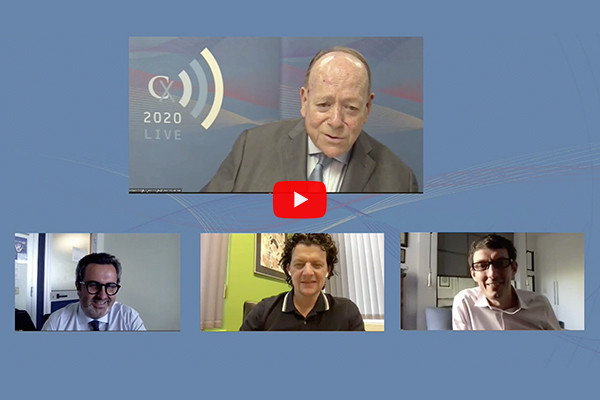Data from three global, real-world registries, GREAT, ExCeL and BSET-CLEVAR, evaluating the Excluder Conformable abdominal aortic aneurysm (AAA) Endoprosthesis with Active Control System, were shared online during the CX 2020 LIVE virtual, vascular conference. Broadcast to a global audience at the conclusion of the second session of CX 2020 LIVE, a trio of expert speakers took part in the Industry Symposium—sponsored by Gore—titled “Continuing the pattern of performance” to discuss the effectiveness and conformability of these endovascular aneurysm repair (EVAR) devices. The symposium featured presentations from Jan Heyligers (Tilburg, The Netherlands), Giovanni Pratesi (Genoa, Italy), and Colin Bicknell (London, United Kingdom).
GREAT registry insights on durability of EVAR using the Excluder device
Commencing the session, Heyligers discussed key findings at different time points from GREAT (Global Registry for Endovascular Aortic Treatment), which he said offer “valuable information on real-world performance” of Gore’s C3 Excluder device. According to Heyligers, the results show that the Gore Excluder, with the C3 delivery system, “demonstrates sustainable durability at short-, mid- and long-term” as well as “acceptable” re-intervention rates and “low AAA [abdominal aortic aneurysm] adverse events.”
Early results presented by Heyligers looked at 30-day outcomes of EVAR in challenging aortic neck morphology using the C3 Excluder, including individual patient data prospectively collected over a two-year period from centres across Europe. These data demonstrated that the C3 delivery system allows for safe repositioning, also in patients outside instructions for use (IFU), noted Heyligers. “It is effective and facilitates EVAR in challenging anatomy,” he added, conceding, though, that longer follow-up was needed.
One-year results presented by Heyligers included data from 400 patients and showed that repositioning with the C3 system before final deployment is “feasible, safe, and useful in real-life conditions, contributing to precise proximal placement”. The results demonstrated graft repositioning in 48% of patients (192), most frequently for level readjustment with regard to the renal arteries, while final intended position of the stent-graft below the renal arteries was achieved in 96.2% of patients. Estimated patient survival was noted as 96% at one year, and 90.6% at two years, Heyligers said. The penultimate study he presented concerned the mid-term (53.5 months median) follow-up and showed freedom from all-cause mortality at 75% within IFU and a “low incidence” (0.9%) of type I or type III endoleaks.
The final of Heyligers’ four studies referred to outcomes of the Gore iliac branch endoprosthesis (IBE) placed in combination with the Excluder device, comparing investigational device exemption (IDE) data with data from the registry. This included data from 99 patients in the IDE trial, and 92 from the GREAT Registry, which Heyligers said showed “continued excellent outcomes for iliac aneurysm treatment using the Gore IBE through two years” and a low incidence of device-related thombotic events requiring reintervention.
Overall, within GREAT, 3,264 patients had an Excluder implanted, Heyligers related, with mortality through five years reported as 17.8% and device-related reinterventions seen in 5.3% of cases. A total of 5.7% of patients had endoleaks that were primarily type II (4.2%) and there were no cases at all of type IV endoleaks observed. The number of aortic ruptures was also shown to be “very low”, in just 0.3% of cases. Heyligers also noted that 63.7% of patients had a decrease in the aortic sac diameter of 5mm or more when compared to baseline, and 23.9% of patients had no change in diameter at all.
On-label endovascular solution for the treatment of short and angulated neck:
Preliminary learnings from the EXCeL Registry
Giovanni Pratesi, (Genoa, Italy), discussed early data from the EXCeL (EXcluder Conformable real Life) Registry, which has enrolled 79 of 150 patients from 11 European sites, assessing safety, treatment success, and absence of occlusion of the Gore Excluder conformable stent graft in patients with challenging anatomies. Challenging proximal aortic neck “remains one of the strongest predictors” of secondary procedures in post-EVAR follow-up,” Pratesi commented, adding that extending on-label treatment to short and angulated neck is “important”, as new generation stent grafts should have a high conformability and precise deployment.
Early 30-day results show freedom from type I and type III endoleaks (98%) for the IFU cohort and 100% in those in the challenging anatomy group (neck angle ≥60 and neck length ≤15 mm), while freedom from reintervention was 98%. Type II endoleak was present in 23% if patients in the IFU group and 17% in the challenging anatomy group. At one year, there were no type I and III endoleaks, no limb occlusion, and freedom from reintervention was 100%, Pratesi reported.
Pratesi noted that the Gore Excluder Conformable has been designed to provide “repositionability, conformability and, for the first time, optional angulation control” and that the device offers a “broad range of on-label use for patients who need EVAR”.
Preliminary learnings from the BSET-CLEVAR
Colin Bicknell (London, United Kingdom), focused on the “very useful” preliminary findings from the BSET-CLEVAR (The British Society of Endovascular Therapy ConformabLe EndoVascular Aneurysm Repair Registry)—a collaboration between the British Society of Endovascular Therapy (BSET) and Gore—intended to report on the device-specific performance outcomes of the Gore Excluder in routine clinical treatment of AAA.
The BSET-CLEVAR study management group additionally comprises Rachel Bell, Jon Boyle, Michael Jenkins, Chris Twine, Rao Vallabhaneni, and Pinar Ulug.
The Gore Excluder Conformable device “has significant potential to change the way angulated necks might be treated during EVAR”, noted Bicknell, who added that the experience gained in using the device in the first cohort of patients is useful and growing.
He added that graft positioning is more predictable when deployment speed is faster and explained that “most of our operators have found that angulation control is most responsive with the device open rather than during the first stage of deployment.” There is “not always a need” to use angulation control, with the conformability alone “often adequate”. For those cases that still need extending, the aortic extender has been shown to be “predictable in deployment”, he added.
The BSET-CLEVAR registry, which will primarily evaluate the aortic neck area coverage with secondary endpoints of technical and clinical success up to one year, has been put on hold due to the COVID-19 crisis but Bicknell stated that “we are aiming to ensure there is adequate evidence from a well-designed registry of the device as soon as the global pandemic has passed”.
This coverage has been supported by an educational grant from Gore.










